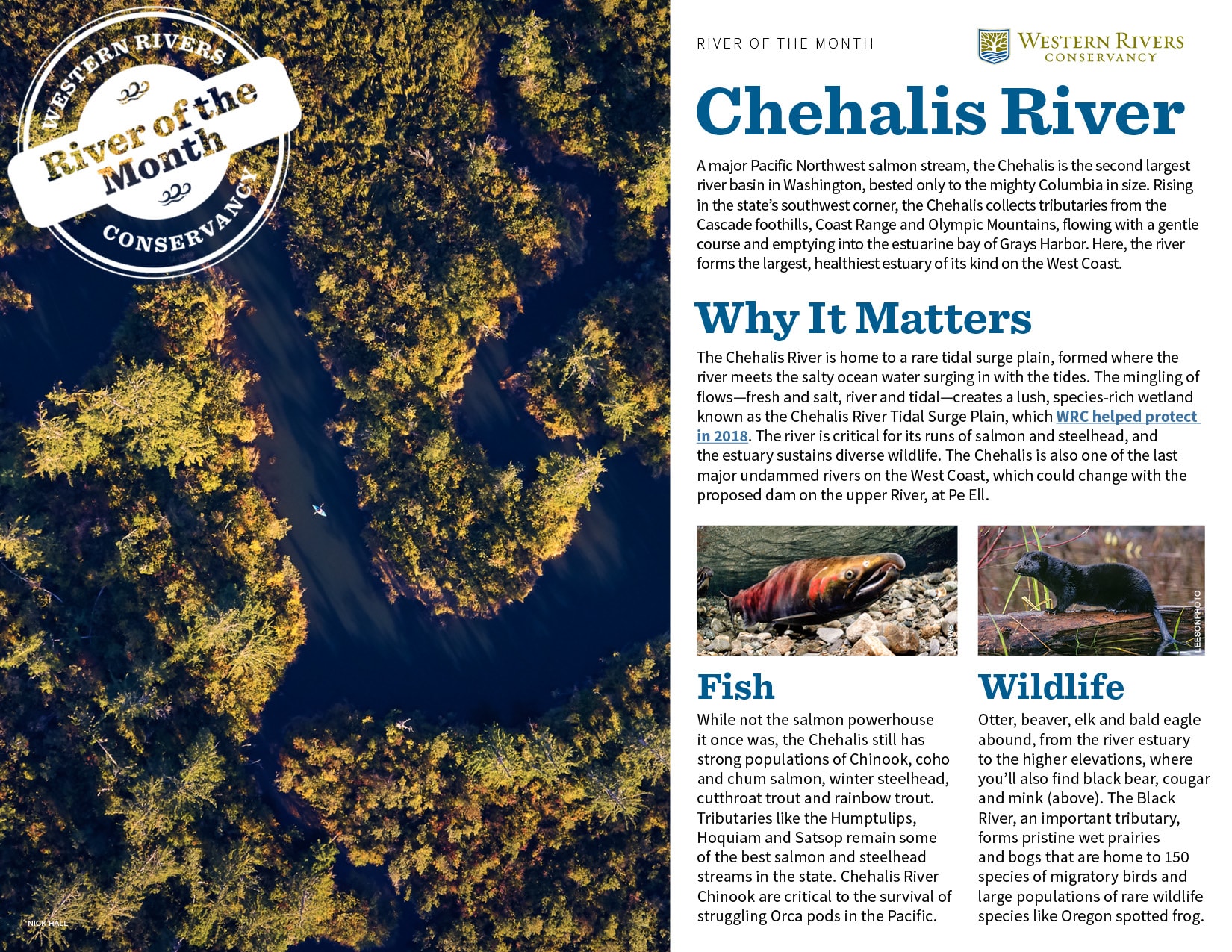
Fish
While not the salmon powerhouse it once was, the Chehalis still has strong populations of Chinook, coho and chum salmon, winter steelhead, cutthroat trout and rainbow trout. Tributaries like the Wynoochee, Hoquiam and Satsop remain some of the best salmon and steelhead streams in the state. Chehalis River Chinook are critical to the survival of struggling orca pods in the Pacific.

Wildlife
Otter, beaver, elk and bald eagle abound, from the river estuary to the higher elevations, where you’ll also find black bear, cougar and mink (above). The Black River, an important tributary, forms pristine wet prairies and bogs that are home to 150 species of migratory birds and large populations of rare wildlife species like Oregon spotted frog.

-
Paddle
Extensive water trails await paddlers in the Surge Plain preserve, where secluded sloughs meander through a 4,494-acre wetland preserve (see Conservation). The Black River is another gem of a day-float with superb birding. It’s possible to float the lower (though mostly developed) 90 miles of the Chehalis, from Rainbow Falls State Park to Grays Harbor, which two adventurous reporters from The Daily Chronicle of Lewis County did back in 2008.
-
Hike
The Chehalis River Surge Plain is just as enjoyable on foot via an easy, seven-mile interpretive trail where you may spot osprey, otter and beaver beneath spruce and cedar trees that tower over the estuary. Upstream, a beautiful way to see the river is to hike (or bike) a segment of the 56-mile-long Willapa Hills Trail, a former railroad that connects the towns of Chehalis and South Bend.
-
Fish
The first big rain brings king, coho and chum salmon into the Chehalis River and tributaries like the Wynoochee and Satsop. The Wynoochee is known for both its winter and summer steelhead runs and is best fished with a boat. The Satstop and its tributaries are popular for salmon.
The WRC Story
In 2018, WRC helped complete the 4,494-acre Chehalis River Surge Plain Natural Area Preserve, a rare type of wetland where the ocean tides surge into the fresh water, branching into winding finger-like channels, lined with water-loving plants and conifers. These quiet sloughs shelter diverse fish and wildlife, including spring and fall Chinook, coho and chum salmon, Olympic mudminnow, steelhead, river otter and beaver. In 1989, much of the surge plain was protected by the Washington Department of Natural Resources. Thirty years later, WRC was able to realize the initial vision of protecting the entire surge plain by partnering with Weyerhaeuser and transferring the remaining 1,469 acres to DNR. Now complete, the preserve provides paddlers with an outstanding system of water trails and offers hikers a series of trails to explore the lush wetland.


Best Time of Year
- Salmon fishing
- Sep-Nov
- Steelhead fishing
- Jan-Mar
- Hiking
- Year-round
- Chehalis River
- Year-round
Go Deeper
-
Preserving Washington’s Biggest and Best Tidal Surge Plain
(Washington Department of Natural Resources)
Learn More -
Go Discover: Willapa Hills State Park Trail
(Washington State Parks)
Learn More -
Chehalis River, a Bit Different Than Other Western Washington Rivers
(Washington Landscape)
Learn More -
Flooding, fish vulnerability being weighed in proposal for dam along Chehalis River
(King5)
Learn More


